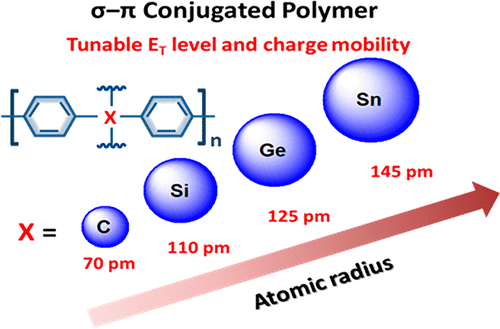当前位置:
X-MOL 学术
›
ACS Appl. Mater. Interfaces
›
论文详情
Our official English website, www.x-mol.net, welcomes your
feedback! (Note: you will need to create a separate account there.)
Optoelectronic Properties of High Triplet σ–π-Conjugated Poly[(biphenyl group IV-A atom (C, Si, Ge, Sn)] Backbones
ACS Applied Materials & Interfaces ( IF 8.3 ) Pub Date : 2019-09-26 , DOI: 10.1021/acsami.9b11496 Miao-Ken Hung,Kuen-Wei Tsai,Sunil Sharma,Jian Lei,Jun-Yi Wu,Show-An Chen
ACS Applied Materials & Interfaces ( IF 8.3 ) Pub Date : 2019-09-26 , DOI: 10.1021/acsami.9b11496 Miao-Ken Hung,Kuen-Wei Tsai,Sunil Sharma,Jian Lei,Jun-Yi Wu,Show-An Chen

|
A series of σ–π-conjugated polymers composed of biphenyl and X atom as backbone repeat unit (where X is the group IV-A atom: carbon, silicon, germanium, or tin) grafted with two alkoxy-substituted biphenyls at the X atom as side chains are synthesized and their optoelectronic properties are studied systematically. We choose biphenyl rather than alkyl as the side chain because its frontier molecular orbital distributions are close to those of our previously reported σ–π-conjugated polymer grafted with transport moieties. The present σ–π polymers with various X atoms show significant differences in triplet energy (ET) ranging from 2.58 to 2.83 eV with the sequence Ge > Si > C > Sn and in charge mobilities from 10–9 to 10–7 cm2/(V s) with the sequence Si > Ge > Sn > C, indicating that the properties of the σ–π polymers are largely affected by their X atoms. The Ge- and Sn-based σ–π-conjugated polymers show the highest and lowest ET values, respectively, due to their different levels of π-electron delocalization caused by size effects and (d–p)π orbital interaction. For their charge transport properties, the Si-based conjugated σ–π polymer gives the highest hole and electron mobilities due to the stronger σ–π conjugation and shorter Si–C bond length between the attached carbon atom in biphenyl and Si. On the contrary, the C-based σ–π-conjugated polymer gives the lowest charge mobilities due to a lack of d orbital in the C atom leading to a poor σ–π conjugation characteristic. These σ–π polymers with different ET levels and charge transport properties show a significant effect on their electroluminescence characteristics. Among them, the Ge-based σ–π-conjugated polymer when used as host shows the best device performance due to its higher ET and reasonable charge mobility. Such findings of different optoelectronic properties of these σ–π-conjugated polymers provide useful guidelines for the selection of backbone for designing σ–π-conjugated polymer host grafted with charge transport moieties.
中文翻译:

高三重态σ-π共轭聚[(联苯基IV-A原子(C,Si,Ge,Sn)]骨架的光电性能
一系列由联苯和X原子作为主链重复单元(其中X是IV-A原子:碳,硅,锗或锡)组成的一系列σ-π共轭聚合物,在该X原子上接枝了两个烷氧基取代的联苯合成侧链并系统地研究其光电性能。我们选择联苯而不是烷基作为侧链,因为它的前沿分子轨道分布与我们先前报道的嫁接有运输部分的σ-π共轭聚合物的分子轨道分布接近。当前具有各种X原子的σ-π聚合物在三重态能量(E T)范围从2.58至2.83 eV的显着差异,其顺序为Ge> Si> C> Sn,电荷迁移率为10 –9至10 –7 cm 2/(V s)的序列为Si> Ge> Sn> C,这表明σ–π聚合物的性质在很大程度上受到X原子的影响。基于Ge和Sn的σ-π共轭聚合物分别显示出最高的E T值和最低的E T值,这是由于它们的大小效应和(d-p)π轨道相互作用引起的π电子离域水平不同。就其电荷传输性质而言,由于联苯和硅中连接的碳原子之间较强的σ-π共轭和更短的Si-C键长度,Si基共轭σ-π聚合物具有最高的空穴和电子迁移率。相反,由于C原子中缺乏d轨道,导致σ-π共轭特性较差,基于C的σ-π共轭聚合物给出的电荷迁移率最低。这些σ-π聚合物具有不同的E T水平和电荷传输性质对其电致发光特性显示出显着影响。其中,Ge基σ-π共轭聚合物用作基质时,由于其较高的E T和合理的电荷迁移率而显示出最佳的器件性能。这些σ-π共轭聚合物的不同光电性质的发现为选择骨架以设计接枝有电荷传输部分的σ-π共轭聚合物宿主提供了有用的指导。
更新日期:2019-09-26
中文翻译:

高三重态σ-π共轭聚[(联苯基IV-A原子(C,Si,Ge,Sn)]骨架的光电性能
一系列由联苯和X原子作为主链重复单元(其中X是IV-A原子:碳,硅,锗或锡)组成的一系列σ-π共轭聚合物,在该X原子上接枝了两个烷氧基取代的联苯合成侧链并系统地研究其光电性能。我们选择联苯而不是烷基作为侧链,因为它的前沿分子轨道分布与我们先前报道的嫁接有运输部分的σ-π共轭聚合物的分子轨道分布接近。当前具有各种X原子的σ-π聚合物在三重态能量(E T)范围从2.58至2.83 eV的显着差异,其顺序为Ge> Si> C> Sn,电荷迁移率为10 –9至10 –7 cm 2/(V s)的序列为Si> Ge> Sn> C,这表明σ–π聚合物的性质在很大程度上受到X原子的影响。基于Ge和Sn的σ-π共轭聚合物分别显示出最高的E T值和最低的E T值,这是由于它们的大小效应和(d-p)π轨道相互作用引起的π电子离域水平不同。就其电荷传输性质而言,由于联苯和硅中连接的碳原子之间较强的σ-π共轭和更短的Si-C键长度,Si基共轭σ-π聚合物具有最高的空穴和电子迁移率。相反,由于C原子中缺乏d轨道,导致σ-π共轭特性较差,基于C的σ-π共轭聚合物给出的电荷迁移率最低。这些σ-π聚合物具有不同的E T水平和电荷传输性质对其电致发光特性显示出显着影响。其中,Ge基σ-π共轭聚合物用作基质时,由于其较高的E T和合理的电荷迁移率而显示出最佳的器件性能。这些σ-π共轭聚合物的不同光电性质的发现为选择骨架以设计接枝有电荷传输部分的σ-π共轭聚合物宿主提供了有用的指导。


















































 京公网安备 11010802027423号
京公网安备 11010802027423号